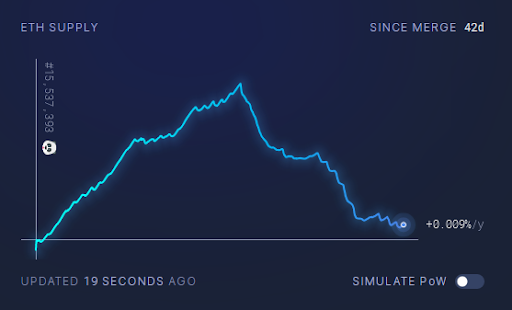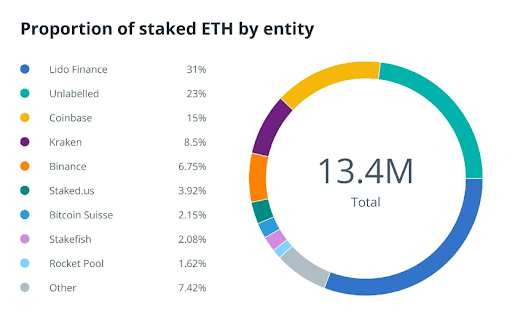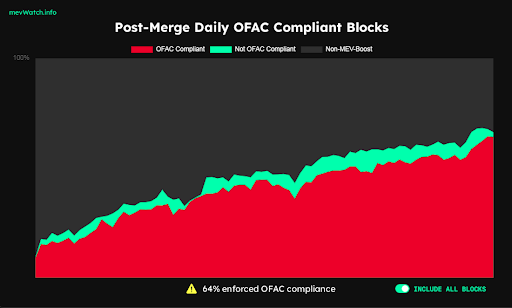The PoS Era: How the Market Welcomes Post-Merge Ethereum
Although the impact of this pivotal event is to unfold over the next few years, some effects are already present. Here, we analyze how Ethereum has changed in the weeks following the Merge.
Key takeaways:
- ETH has lost 19% of its price since Sept. 15, but entered a recovery phase – and the positive long-term effects of deflation are anticipated.
- Ethereum staking entities and block relayers (organizations verifying MEV-boost blocks) show signs of high centralization, paving the way for transaction censorship.
- Users point to difficulties in setting up solo staking.
- Ethereum has become more sustainable than expected: the network consumes 99.99% less energy compared to the pre-Merge era.
- The rebellious EthereumPoW network that forked from original Ethereum shows poor signs of adoption.

Ethereum Price Crash: How Disappointing Is It?
Despite the ‘uneventful’ Merge, the update didn’t boost the Ethereum price. On the contrary, ETH value declined to a local minimum: it lost 19% from the pre-Merge peak, although has almost recovered later as the crypto market entered a new rally. The echoing on-chain activity to the price decline was a massive ETH dump: whales have sold over $4 billion worth of ETH over the last few weeks.
This pattern corresponds to the old rule: ‘buy the rumor, sell the news’. The Merge had been widely discussed long before it happened, so the market has already had a chance to react. No one really was expecting a surge.
Moreover, the Merge is likely to have a primarily long-term effect on ETH price. The update has laid the ground for scaling updates that will reduce fees and increase throughput in Ethereum across 2023-2024, making it a backbone of web3.
Deflation is going to do a part of the job, too.
Ethereum deflation: burned gas fees plus lowered rewards
In Ethereum, the supply is determined by how much ETH is issued and burned. The way to cut the supply (and push the price up) is to issue less coins and burn more.
- Issue less. Prior to the Merge, miners received about 13,000 ETH in rewards daily, and stakers got 1,600 ETH. Ethereum inflation rate was about 4.62%. After mining was abandoned, ETH emission dropped by 90%.
- Burn more. Throughout most of Ethereum’s history, barely any coins were burned. In 2021, the London hard fork changed this – since it was adopted, ETH gas fees have been burned depending on the network load. This gave Ethereum the means to reduce supply – and make it deflationary.
As of October 27, Ethereum inflation rate was as low as 0.009% in annual terms – Ethereum supply has increased only by approx. 1,200 coins since the Merge. If the update were not to happen, the supply would grow by about 500,000 ETH, and the inflation would hit 3.6%.
Coin burns and reduced rewards have cut Ethereum inflation down almost to zero. This is certainly a long-term bullish sign for ETH price.

Ethereum Faces Problems Following the Merge
Centralization
During the first post-Merge hours, Ethereum was caught on high centralization rates – however, the first signs of this were present even before the update.
In September 2022, a blockchain analytics firm Nansen calculated that 61.25% of all staked Ethereum is spread across just 4 platforms. The combined share of 3 centralized exchanges – Coinbase, Kraken и Binance – exceeded 30%.

September data by Nansen. Image source
This is how the Merge makes Ethereum more vulnerable to censorship. Centralized exchanges must comply with the state sanctions policy and may ban transactions. Decentralized Lido protocol (holds 31% of staked ETH) shows high levels of governance token concentration – and also carries censorship risk. Ethereum co-founder Vitalik Buterin acknowledged these issues at a developers’ call back in August.
According to Santiment market intelligence platform, 46% of Ethereum blocks were added to the blockchain by just two addresses on the first post-Merge day. “This heavy dominance by these addresses is something to watch,” said company analysts.
And the fears were not unreasonable.
MEV-boost censorship and OFAC compliance
As of October 16, 2022, the U.S. government censors over a half of Ethereum blocks. How’s this possible, and what does it have to do with MEV – Ethereum’s “invisible tax”?
What are MEV-boost block relayers?
MEV, or Maximum Extractable Value, allows Ethereum validators to raise their profit by manipulating the order of transactions. Although MEV helps fix market inefficiencies, it increases gas costs for all users. Almost $700 million of “invisible tax” have been extracted since 2020.
To reduce the impact of MEV, a centralized research organization Flashbots created a mechanism that democratizes access to MEV profits. It separates block creation and validation:
- There is an open market of block builders who make up profitable combinations of transactions,
- These transaction bundles are verified by block relayers,
- Relayers pass these blocks to validators.
MEV-boost is an iteration of this mechanism suitable for post-Merge Ethereum. Flashbots has made its code open-source so that other organizations could develop their own MEV relays.
However, this quest for decentralization has gone wrong.
Most relays are controlled by the government
According to the MEV-boost tracker, over 81% of MEV-enabled blocks are relayed by Flashbots themselves. Moreover, Flashbots dashboard shows that the organization relays 58% of all Ethereum blocks (not only those using MEV-boost), compared to 12% on September 15, the first post-Merge day.
This dependency raises concerns about a single point of failure in the Ethereum ecosystem – but even more importantly, provides the basis for censorship. Research shows that Flashbots have censored transactions from Tornado Cash, a mixing service blacklisted by the OFAC – an agency responsible for U.S. economic sanctions. Tornado Cash has been widely used for money laundering, but many industry players perceived its ban as severe pressure on the crypto market.
Here’s the root of the problem: MEV-boost relays are centralized businesses that must implement sanctions by the law. According to the MEV Watch portal, 64% of all Ethereum blocks are OFAC-compliant. Martin Köppelmann, co-founder of Gnosis infrastructure platform, warns: “if the censoring validators would now stop attesting to non-censoring blocks, they would eventually form the canonical, 100% censoring chain.”
For truth’s sake, Köppelmann said the same about the first cryptocurrency: _“No, dear Bitcoin fans, it is not better in Bitcoin. In fact you need only 4 entities to come to >72%.” _It’s not correct to directly compare Bitcoin mining pools and major Ethereum stakers, though: pools are made up of independent individual miners, while stakers like Binance or Coinbase act as centralized entities.

Percentage of OFAC-compliant blocks. Image source
It’s hard to set up solo staking
As Ethereum switched to Proof of Stake, users found it difficult to start staking ETH on their own node. A user who raised this issue on Reddit had spent a weekend debugging the validator node, given that he was quite tech-savvy. "Staking is too difficult for common folk to do,” he said – and this may hinder Ethereum’s decentralization.
Some users argued in response that “staking is work, too” and requires time, just as mining did. But technical difficulty isn’t the only problem with Ethereum staking – 32 ETH (~$49,600) is quite a high entry threshold.
Reddit users pointed out that these obstacles push users to centralized services like Binance and Coinbase – which poses risks discussed above.
Did Ethereum Become Eco-Friendly After Merge?
Before the Merge, Ethereum produced 12 million tons of CO2 annually and 27 kg per transaction. Vitalik Buterin expected that the update would reduce global energy consumption by 0.2%.
On September 15, Crypto Carbon Ratings Institute released a report: the network slashed electricity usage even more than expected. Ethereum’s energy needs and carbon footprint both dropped by 99.99%, compared to 99.95% as forecasted by the Ethereum foundation. The post-Merge blockchain is expected to generate only 870 kilograms of CO2 per year – less than the average 100 American households.
There is, however, one important caveat to this data. Hashrate of some Proof of Work chains has increased after the Merge, so at least part of the Ethereum miners switched to EthereumPoW, Ethereum Classic, Ravencoin, and Ergo. In the meantime, the possibility to use original Ethereum rigs to mine other coins is limited, and many enthusiasts have abandoned mining after the Merge.
What’s Up with EthereumPoW?
As the Merge loomed, a defiant group of miners claimed they would continue mining original Ethereum under the name EthereumPoW. Experts called the fork unviable, and the chain has had quite a bit of trouble while trying to launch.
Weeks after the Merge, ETHW blockchain is operating. The coin is trading at $7 – it’s a 86% loss from its $49.5 peak on September 15 and a 96% drop compared to the ETHW announcement date. The network’s hashrate is about 32 TH/s – the original Ethereum had 900 TH/s one week prior to the Merge.
EthereumPoW’s TVL is only $6.7 million, no original Ethereum DeFi or gaming protocols have ever emerged in its ecosystem. An example of a ETHW-based project is the UniWswap DEX.
Next Stop: Scalable Ethereum
When the Merge went live, Cardano founder Charles Hoskinson said that the update was overhyped. “You do understand that nothing has changed in terms of performance, operating cost, nor liquidity?”, he uttered and criticized Ethereum for not looking into Cardano’s Ouroboros. In fact, the recent Vasil update in the ADA network has instantly increased Cardano performance and reduced fees. Then, what was Hoskinson missing?
The Merge has laid the ground for the next Ethereum update known as the Surge, scheduled to happen sometime in 2023. It will introduce sharding, allowing the blockchain to process up to 100,000 transactions per second. Unlike Cardano, Ethereum was co-founded by Hoskinson as a Proof of Work blockchain, so it needs a while to implement all of the fundamental changes.
The bold transition to Proof of Stake has set an example for the entire industry. Vitalik Buterin expressed hope that as this consensus algorithm matures, more PoW chains will leverage it in the future. And there’s already a hint this may come true – ZCash and Dogecoin have announced looking into the possibility of migrating to PoS. Highly efficient and sustainable crypto industry may be closer than we think it is.



